Family : Balistidae

Text © Giuseppe Mazza

English translation by Mario Beltramini
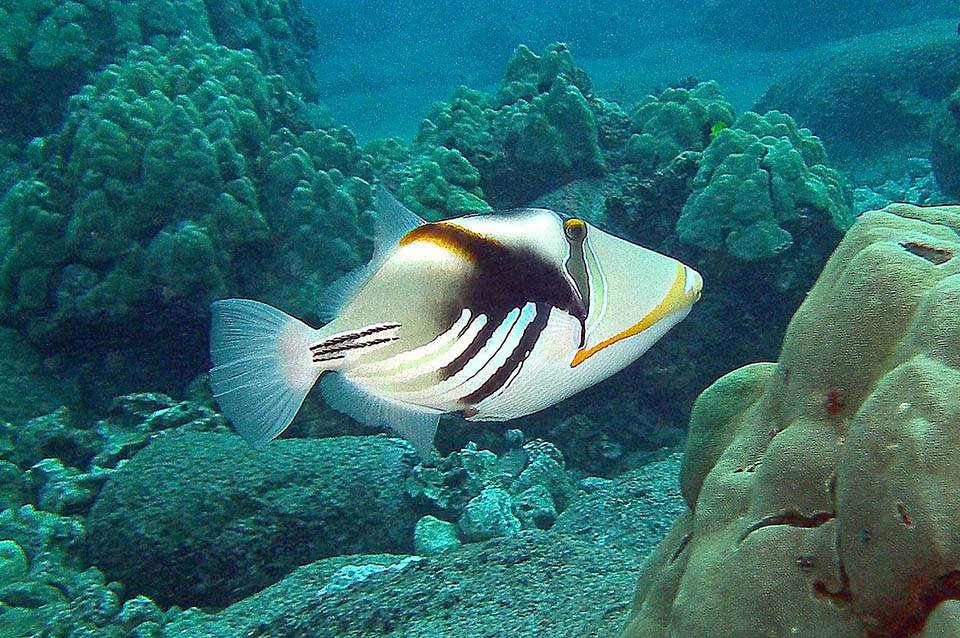
About 15 cm long, but even 30 cm, Rhinecanthus aculeatus has a very vast distribution in the tropical waters of eastern Atlantic Ocean and of Indo-Pacific © Barry Fackler
The showy White-banded triggerfish also known as Hawaiian Triggerfish and Picasso triggerfish (Rhinecanthus aculeatus Linnaeus, 1758) belongs to the class of Actinopterygii, the ray-finned fishes, to the order of the Tetraodontiformes and to the family of Balistidae, the so-called triggerfishes.
The name of the genus Rhinecanthus comes from the Greek “rhinos”, nose, snout and from “ahantha”, spine, with probable reference to the particularly elongated snout for a Balistidae and to the dorsal spine.
The specific epithet, given by Linnaeus, comes from the Latin adjective “aculeatus”, with spines, and underlines the presence of spines in the caudal peduncle.
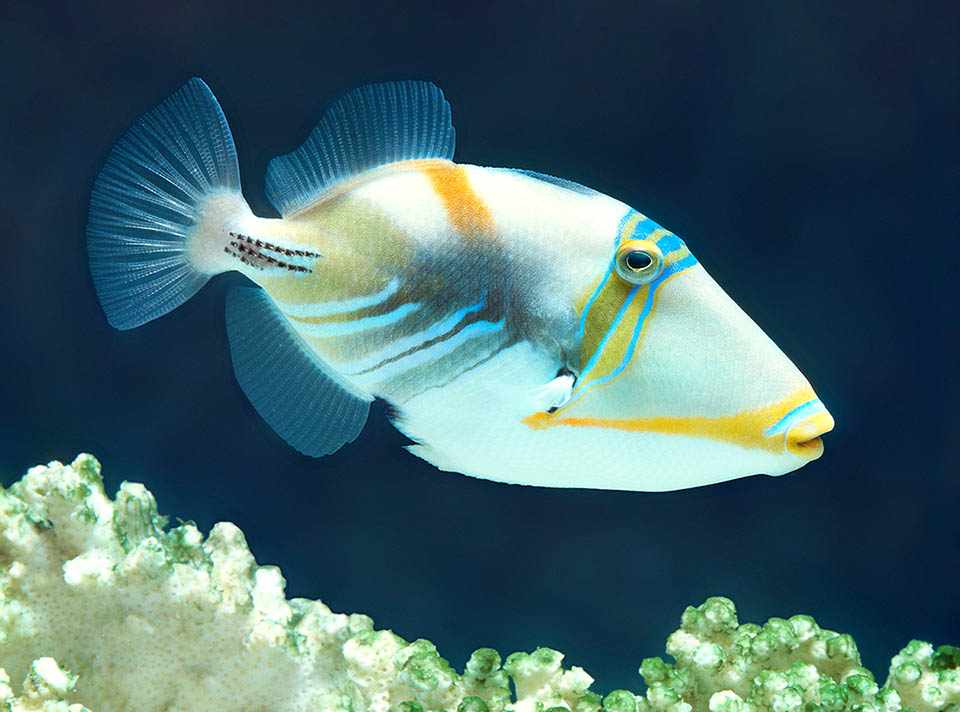
Known as Hawaiian Triggerfish, because of the odd brushstrokes of colour, loves the sandy zones among the madreporic formations where it descends to a depth of 50 m © Giuseppe Mazza
Zoogeography
Rhinecanthus aculeatus has a very vast distribution. As a matter of fact, we find it in the tropical waters of the Atlantic Ocean as well as in those of the Indo-Pacific.
It is present along the African coast from Senegal to South Africa and then goes northwards up to the Red Sea. As an indication, it is frequent also in the Seychelles Islands, Mauritius, Réunion and Maldives, in India, Sri Lanka, Thailand, Australia, Indonesia, New Guinea, Micronesia, Philippines, Taiwan and in China up to southern Japan.
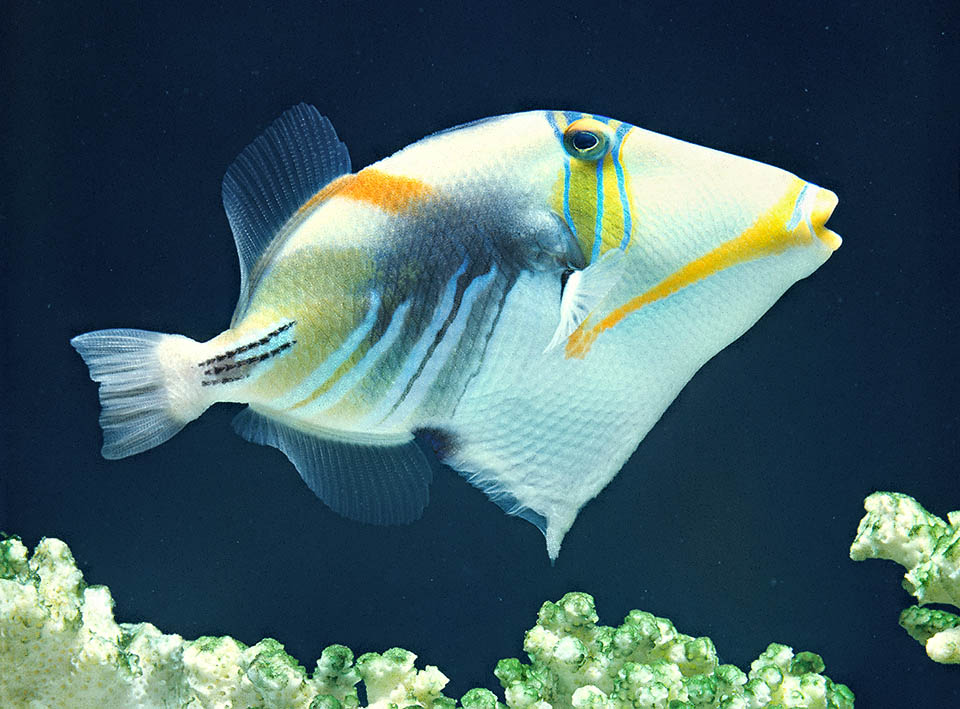
There are no pelvic fins, merged in a sort of spine, well visible when the fish spreads, menacing, the belly to seem bigger and to deter the aggressors © Giuseppe Mazza
Eastwards, it is at home in Kiribati, Samoa, the Marquesas Islands, Tuamotu and the Hawaii. In the southern hemisphere, it reaches Tonga, New Caledonia and Lord Howe islands.
Ecology-Habitat
Rhinecanthus aculeatus loves the sandy zones, with still waters, as it lives among the madreporic formations up to 50 m of depth.
Morpho-physiology
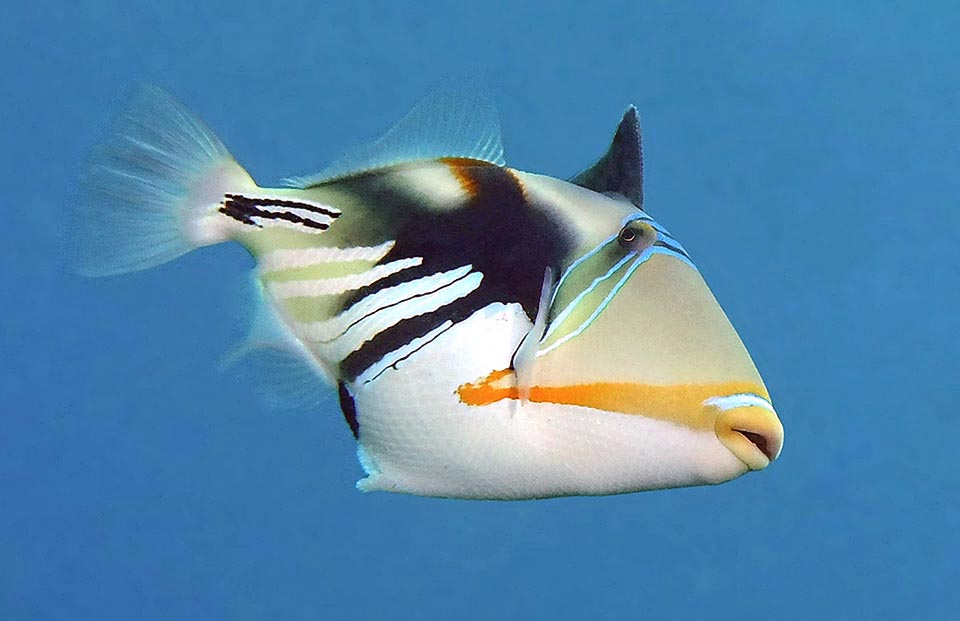
If not enough, it spreads, assuming the profile of a trigger, also the first dorsal fin with the spiny ray, pointed and sharp as a dagger. Once blocked vertically, it remains as such even if the fish passes away. A certainly not appreciated courtesy by the stomach of the predators who in future will try to avoid these fishes © Barry Fackler
It may reach the 30 cm of length, but usually, especially when in aquarium, it does not exceed the 15-20 cm.
The snout is elongated if compared to the other triggerfishes and the body, decidedly flat, seems almost a trapeze when the ventral zone is stretched as intimidation. Like all triggerfishes, it is protected by a solid coating of bony scales. They are scabrous and spiny close to the caudal peduncle.
We note on the back the typical erectile trigger formed by three spines, which the fish can block, for defence, in erect position. The first is long and sharp, like a rapier, and seen that it keeps the position also when the animal is dead, it usually deters the aggressors.
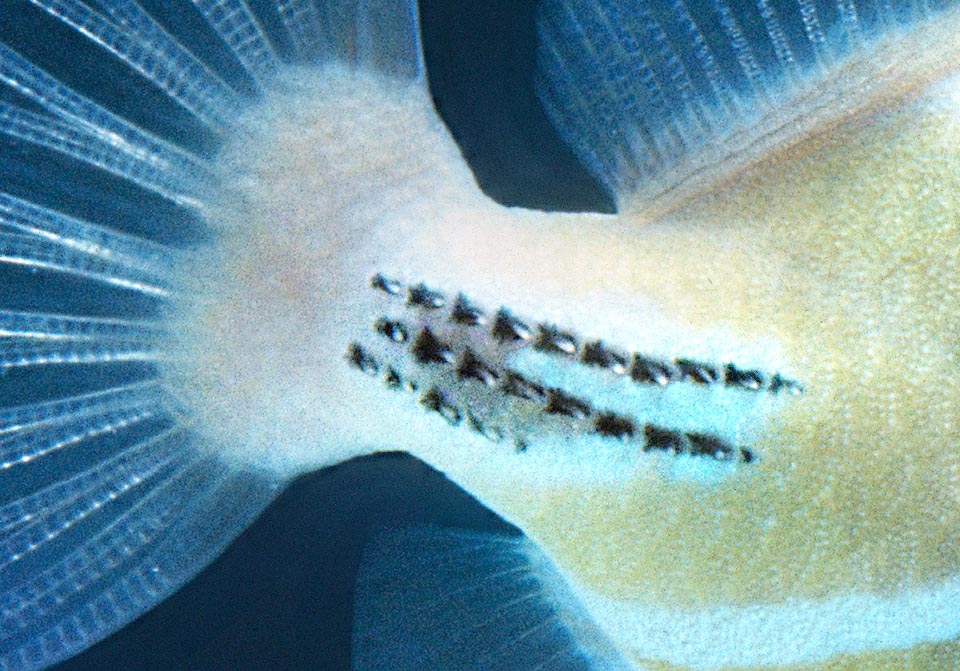
To whip importunates it also has on the tail a series of spines highlighted by black traits, hence the. scientific and common names of Prickly triggerfish © Giuseppe Mazza
The second dorsal fin has 23-26 soft rays and is symmetrical to the anal, which has 21-23 of them. The pectoral ones count 13-16 unarmed rays, the ventral are reduced to a spike and the caudal is rounded in the juveniles and almost truncated in the adults. The mouth, small but robust, is armed by sharp and cutting teeth.
Not wrongly, the livery recalls Picasso’s paintings. On the base colour, almost white in the lower part of the body and cream grey up, stand out in fact some black strokes converging in a central spot.
An orange trait goes from the pectorals to the snout, whilst another crosses the back.
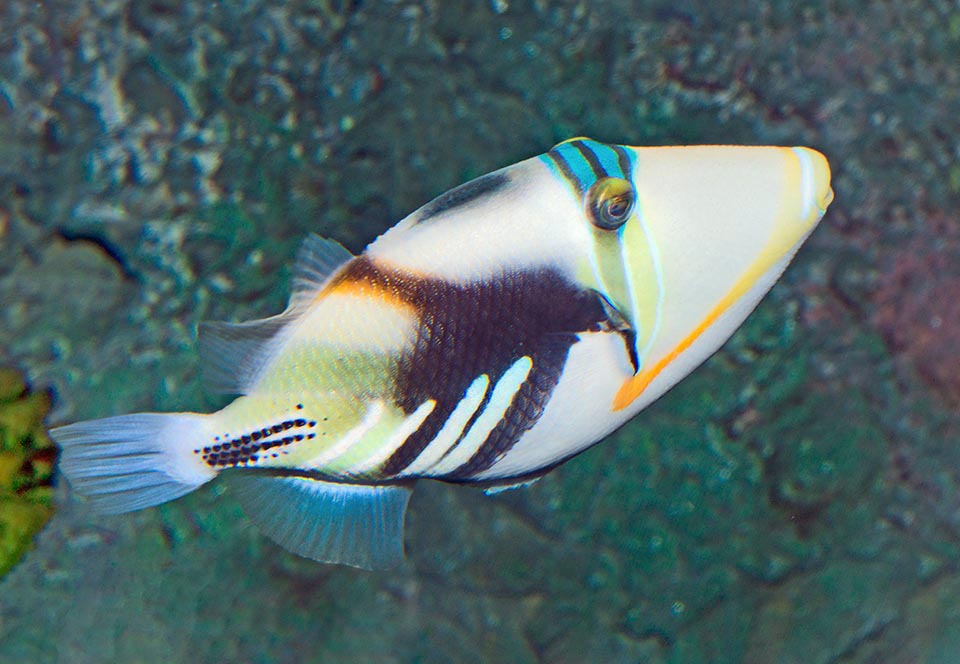
Rhinecanthus aculeatus is a very territorial fish with males that allow entrance into their small kingdom to 2-3 females, each one for a well defined zone © Giuseppe Mazza
Between the pectorals and the eye we note three turquoise vertical bands delimiting a yellow-greenish zone and continuing, widening, on the back where the central one divides in two thus forming 4 bands. Towards the caudal peduncle the background colour turns greenish and some black stripes stand out underlining the presence of spines.
Ethology-Reproductive Biology
The white-banded triggerfish practically nourishes of almost all what it finds: echinoderms, crabs, shrimps, ascidians, tubeworms and eggs of other fishes. It can hole without any difficulty the shells of the bivalves and of the gastropods crumbling as nothing the branches of the madrepores looking for tasty polyps. It eats also small fishes and does not disdain the weeds, the foraminiferans and the debris.
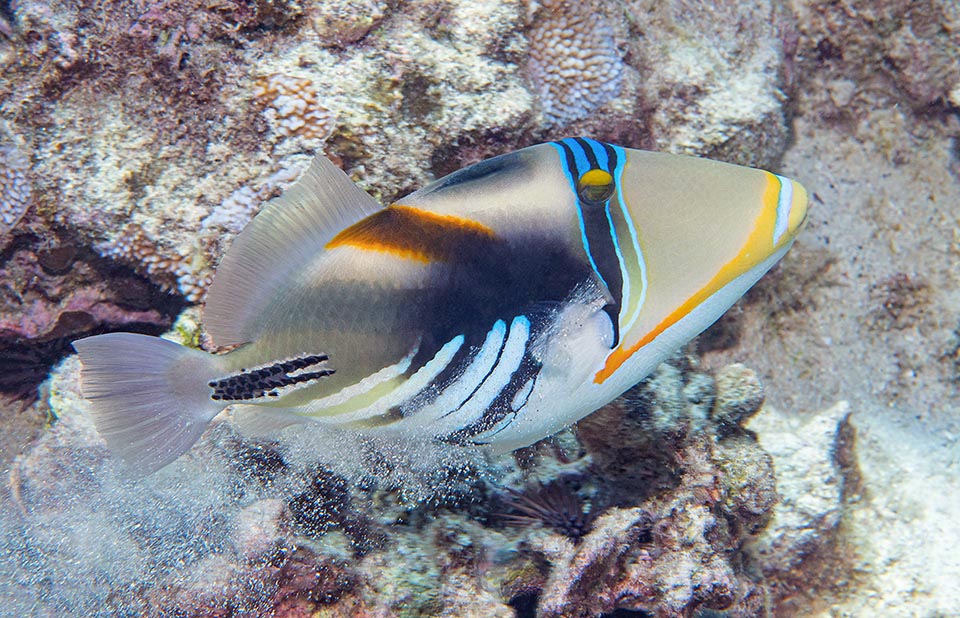
It feeds on invertebrates, flushing out with jets of water from mouth crustaceans and crushed mollusks like corals by strong jaws, but also on small fishes, weeds and debris © Giuseppe Mazza
With such a diet it is clear that it is fully suitable for the aquarium life, even if then do arise problems of incompatibility with its fellows due to the marked territorial instinct, and it is necessary to renounce to the invertebrates and other small species as they sooner or later would end up in its stomach.
In nature, when feeling in danger, before taking shelter among the madrepores it emits strange grunts, possibly an alarm cry for the fellows.
Also when it is taken off from the nets, it puffs into the hands of the fishermen, so much that in the Hawaii they call it “Humu-Humu-Nuku Nuku-apu’a”, which means “fish that once out from the water cries like a pig”.
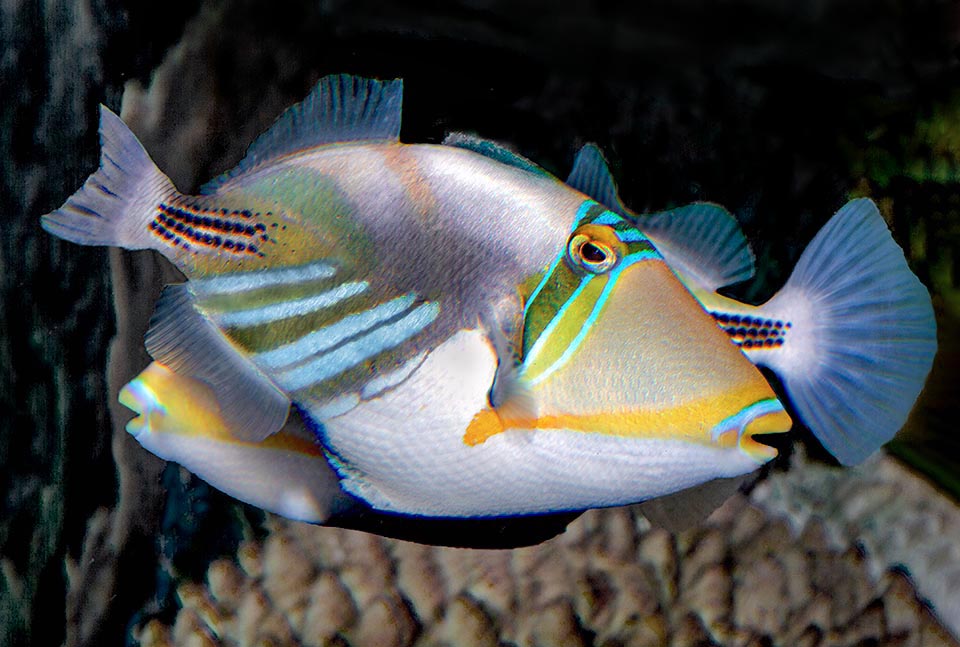
A couple. The eggs are laid in the morning in a nest dug into the sand. They hatch on the same evening and the female displays unusual parental care © Giuseppe Mazza
The eggs, laid in lumps or in stripes in a nest dug into the sand, are surveyed by the female until hatching. It
oxygenates them by ventilating them with its fins, and defends them with bites from the fishes and from the starfishes that are greedy of them. Laid in the morning, they already hatch in the evening and the mother follows its fry for a while longer.
Usually, in the fishes spawning on the seabeds, the watch is mainly entrusted to the males, but here, after the fecundation, these ones only care of defending the boundaries of their small kingdom that hosts usually 2 or 3 females. An Indian study has shown that the number of the eggs laid is relatively modest, standing between 936 and 7262, almost nothing if compared with those, for instance, of the Yellowmargin triggerfish (Pseudobalistes flavimarginatus) with the females that release even 430.000 of them per litter. The Picasso triggerfish would therefore essentially compensate the lesser number of eggs with bigger parental cares.
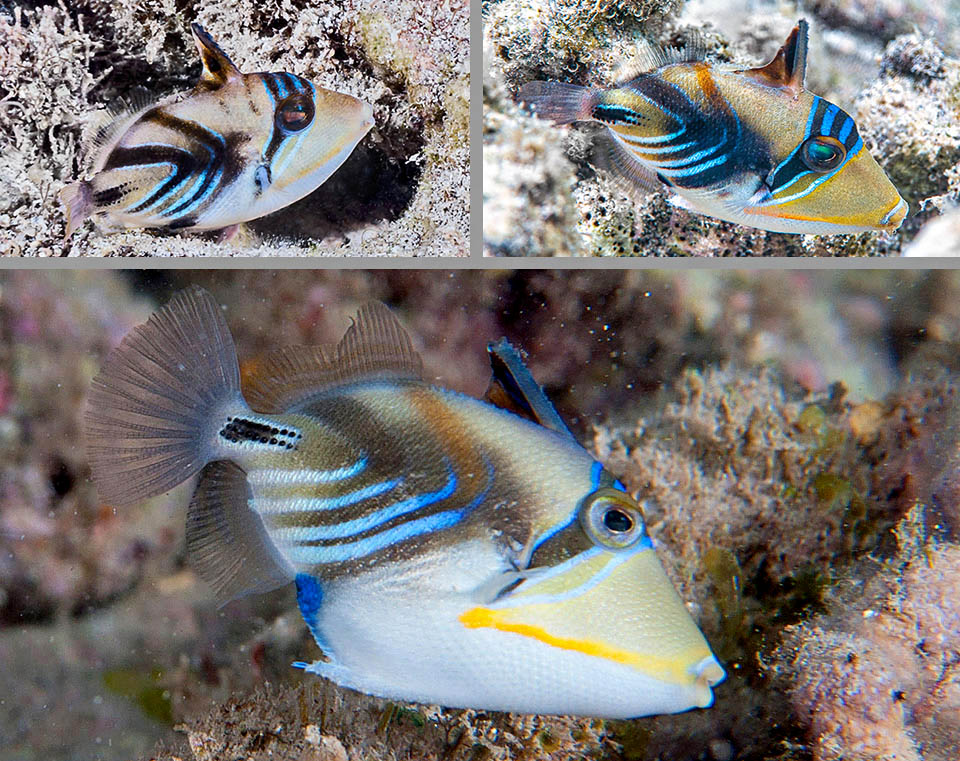
Juvenile growth stages. The livery is different from the adult’s but they already have the typical defensive dorsal fin of the species © François Libert
The resilience is good with a possible doubling of the populations in less than 15 months, and even if this species sometimes gets onto the nets and is caught young for the aquaria, the fishing vulnerability index is presently modest, marking only 30 on a scale of 100.
However it is still not well known the trend of the populations. Rhinecanthus aculeatus is therefore presently under observation, inserted in the Red List of the endangered species as “Least Concern”, that is “Minor Worry”.
Synonyms
Balistapus aculeatus Linnaeus, 1758; Balistes aculeatus Linnaeus, 1758; Balistes heteracanthus Bleeker, 1859; Balistes ornatissimus Lesson, 1831; Monacanthus cheverti Alleyne & Macleay, 1877.
→ For general information about FISH please click here.
→ For general information about BONY FISH please click here
→ For general information about CARTILAGINOUS FISH please click here.
→ To appreciate the BIODIVERSITY of BONY FISH please click here.
→ To appreciate the BIODIVERSITY of CARTILAGINOUS FISH please click here.
